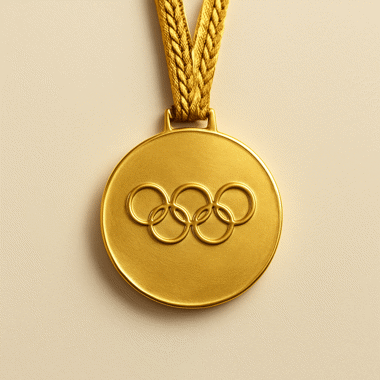What is Gold Vermeil? Everything You Need to Know
What is gold vermeil?
Gold vermeil (pronounced ver-may) refers to a metalworking technique that involves applying a high-quality layer of gold over a base of sterling silver. This term is defined by strict criteria in many countries, especially the UK, and is different to standard gold plating.
To be classified as gold vermeil, an item must meet the following criteria:
- The gold layer must have a purity of at least 10 carats.
- The gold layer must have a minimum thickness of 2.5 microns.
- The silver must be sterling silver (92.5% pure silver) or higher.
Where did gold vermeil originate?
Coating a metal with gold, also known as ‘gilding’, has existed for thousands of years, from around the 4th century BC. Some very early examples of gilding can be traced back to the ancient Romans who were known to hammer fine gold leaf over silver to make ornamental objects. Similar techniques have also appeared in Ancient Korea, China, and South America.
The technique of gilding and the term ‘gold vermeil’ gained popularity in 18th-century France where it was used for items of prestige such as tableware, ceremonial objects, ornate furniture, royal regalia, and jewellery. Most famously, since 1912, Olympic gold medals have been made of gold vermeil as they are crafted in silver and finished with a layer of gold.
How is gold vermeil made?
Gold vermeil is created using a process called electroplating. Here is how it works:
Base material: An item is crafted from sterling silver and then cleaned and polished to ensure effective bonding.
Gold application: The silver item is submerged in a solution containing dissolved gold ions and is subjected to an electrical current - this causes the ions to be attracted to the silver, resulting in a layer of gold being applied to the surface.
The duration of this process determines the thickness of the gold layer applied to the silver. Unlike lower-grade gold plating, the minimum 2.5-micron thickness required in vermeil often makes it more durable.
How does gold vermeil compare with gold-plated items?
Gold vermeil and gold-plated finishes may look the same at first glance. However, they have some key differences including base metal, gold thickness, and durability.
Gold vermeil will always have a precious metal base (sterling silver), while gold-plated items can use copper, stainless steel, or brass.
The layer of gold on vermeil will measure at least 2.5 microns thick, where gold-plated items may have as little as 0.1-0.5 microns of gold.
Due to its composition, vermeil offers a superior finish to typical gold plating. Gold vermeil is more resilient and will usually wear better over time, while thin gold plating is more likely to rub off more easily with handling or exposure to the elements.
How does gold vermeil compare with solid gold?
Gold vermeil may look similar to solid gold; however, solid gold is made entirely from gold alloy, usually ranging from 9ct to 24ct in purity, and is extremely durable when alloyed properly. Gold vermeil is a layer of gold over silver which can wear or fade when handled over time.
However, for those who don’t require the full density or have the budget for solid gold, vermeil allows for the appearance of gold at a lower cost. It also uses only precious metals, gold and silver, making it more valuable than costume finishes. Vermeil will never replace bullion-grade gold in terms of intrinsic value, but it can bridge the gap between affordability and material quality for some items such as jewellery.
Is gold vermeil durable?
Gold vermeil is often more durable than standard gold-plating due to the required thickness of gold and the sterling silver base. However, this surface coating can still wear down over time if the item is roughly handled regularly, exposed to moisture, or if it comes into contact with chemicals.
For decorative objects and items not subjected to constant heavy handling, vermeil can hold up well. This is why it is often used for ceremonial pieces such as Olympic medals, crown jewels, and historical artefacts. However, it may not be so suitable for pieces designed for constant wear or for use in harsh environments.
To take care of gold vermeil, it is important to avoid polishing with anything abrasive and to limit its exposure to water, sweat, and chemicals. It is a good idea to keep gold vermeil items in a dry, soft container when not in use. When cared for properly, gold vermeil can keep its appearance for many years.
Is gold vermeil used in bullion products?
No, gold vermeil is not used in genuine bullion or investment-grade products. Gold bullion coins and bars are made from solid gold only. Bullion products are valued primarily for their gold or silver content, purity, and weight, while vermeil is purely about appearance and craftsmanship.
Gold vermeil or gilding may appear in some commemorative silver coins, medallions, or collectables – these items are usually bought for display, collecting, or artistic value and not as investment-grade bullion.
In conclusion
Gold vermeil is unique in that it is more valuable and enduring than gold plating, but more affordable than solid gold. Bridging the gap between quality and affordability, vermeil uses only precious metals, gold and silver, which are applied with care and precision. While not suited for bullion items, gold vermeil continues to be a respected finish for a variety of items in the world of precious metals, and one that blends beauty and practicality.
This blog represents one person’s opinion only. Please note, gold and silver prices may go down as well as up. Atkinsons Bullion & Coins accepts no responsibility for any losses based on information we have provided. We do not offer investment advice. Please carry out your own research before making an investment decision.









